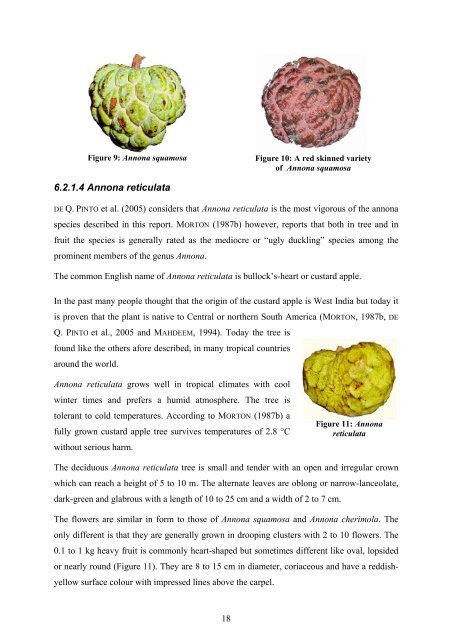Botryodiplodia sp. - Crops for the Future
Botryodiplodia sp. - Crops for the Future
Botryodiplodia sp. - Crops for the Future
Create successful ePaper yourself
Turn your PDF publications into a flip-book with our unique Google optimized e-Paper software.
Figure 9: Annona squamosa<br />
Figure 10: A red skinned variety<br />
of Annona squamosa<br />
6.2.1.4 Annona reticulata<br />
DE Q. PINTO et al. (2005) considers that Annona reticulata is <strong>the</strong> most vigorous of <strong>the</strong> annona<br />
<strong>sp</strong>ecies described in this report. MORTON (1987b) however, reports that both in tree and in<br />
fruit <strong>the</strong> <strong>sp</strong>ecies is generally rated as <strong>the</strong> mediocre or “ugly duckling” <strong>sp</strong>ecies among <strong>the</strong><br />
prominent members of <strong>the</strong> genus Annona.<br />
The common English name of Annona reticulata is bullock’s-heart or custard apple.<br />
In <strong>the</strong> past many people thought that <strong>the</strong> origin of <strong>the</strong> custard apple is West India but today it<br />
is proven that <strong>the</strong> plant is native to Central or nor<strong>the</strong>rn South America (MORTON, 1987b, DE<br />
Q. PINTO et al., 2005 and MAHDEEM, 1994). Today <strong>the</strong> tree is<br />
found like <strong>the</strong> o<strong>the</strong>rs a<strong>for</strong>e described, in many tropical countries<br />
around <strong>the</strong> world.<br />
Annona reticulata grows well in tropical climates with cool<br />
winter times and prefers a humid atmo<strong>sp</strong>here. The tree is<br />
tolerant to cold temperatures. According to MORTON (1987b) a<br />
fully grown custard apple tree survives temperatures of 2.8 °C<br />
without serious harm.<br />
Figure 11: Annona<br />
reticulata<br />
The deciduous Annona reticulata tree is small and tender with an open and irregular crown<br />
which can reach a height of 5 to 10 m. The alternate leaves are oblong or narrow-lanceolate,<br />
dark-green and glabrous with a length of 10 to 25 cm and a width of 2 to 7 cm.<br />
The flowers are similar in <strong>for</strong>m to those of Annona squamosa and Annona cherimola. The<br />
only different is that <strong>the</strong>y are generally grown in drooping clusters with 2 to 10 flowers. The<br />
0.1 to 1 kg heavy fruit is commonly heart-shaped but sometimes different like oval, lopsided<br />
or nearly round (Figure 11). They are 8 to 15 cm in diameter, coriaceous and have a reddishyellow<br />
surface colour with impressed lines above <strong>the</strong> carpel.<br />
18

















